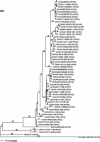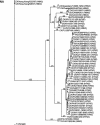Sequence analysis of recent H7 avian influenza viruses associated with three different outbreaks in commercial poultry in the United States - PubMed (original) (raw)
Sequence analysis of recent H7 avian influenza viruses associated with three different outbreaks in commercial poultry in the United States
Erica Spackman et al. J Virol. 2003 Dec.
Abstract
The hemagglutinin (HA) and neuraminidase (NA) genes of H7 avian influenza virus (AIV) isolated between 1994 and 2002 from live-bird markets (LBMs) in the northeastern United States and from three outbreaks in commercial poultry have been characterized. Phylogenetic analysis of the HA and NA genes demonstrates that the isolates from commercial poultry were closely related to the viruses circulating in the LBMs. Also, since 1994, two distinguishing genetic features have appeared in this AIV lineage: a deletion of 17 amino acids in the NA protein stalk region and a deletion of 8 amino acids in the HA1 protein which is putatively in part of the receptor binding site. Furthermore, analysis of the HA cleavage site amino acid sequence, a marker for pathogenicity in chickens and turkeys, shows a progression toward a cleavage site sequence that fulfills the molecular criteria for highly pathogenic AIV.
Figures
FIG. 1.
Phylogenetic tree of the HA gene of H7 subtype AIVs isolated in the Americas (with subtypes noted on the tree). The tree was generated by the maximum parsimony method with PAUP 4.0b10 (heuristic search and 500 bootstrap replicates) and is rooted with CK/Chile/176822/02. AV, avian; CK, chicken; DK, duck; GF, guinea fowl; QU, quail; TK, turkey. The names of the states where the viruses were isolated are represented by their standard two-letter postal codes.
FIG. 2.
Phylogenetic tree of the NA (subtype N2) gene of AIVs isolated in North America (with subtypes noted on the tree). Groupings of H7N2 viruses isolated in the northeastern United States between 1994 and 2002 are shown. The tree was generated by the maximum parsimony method with PAUP 4.0b10 (heuristic search and 500 bootstrap replicates) and is not rooted. AV, avian; CK, chicken; GF, guinea fowl; QU, quail; TK, turkey. The names of the states where the viruses were isolated are represented by their standard two-letter postal codes.
Similar articles
- Changes in the haemagglutinin and the neuraminidase genes prior to the emergence of highly pathogenic H7N1 avian influenza viruses in Italy.
Banks J, Speidel ES, Moore E, Plowright L, Piccirillo A, Capua I, Cordioli P, Fioretti A, Alexander DJ. Banks J, et al. Arch Virol. 2001;146(5):963-73. doi: 10.1007/s007050170128. Arch Virol. 2001. PMID: 11448033 - Characterization of recent H5 subtype avian influenza viruses from US poultry.
Lee CW, Senne DA, Linares JA, Woolcock PR, Stallknecht DE, Spackman E, Swayne DE, Suarez DL. Lee CW, et al. Avian Pathol. 2004 Jun;33(3):288-97. doi: 10.1080/0307945042000203407. Avian Pathol. 2004. PMID: 15223555 - Avian influenza virus subtypes inside and outside the live bird markets, 1993-2000: a spatial and temporal relationship.
Panigrahy B, Senne DA, Pedersen JC. Panigrahy B, et al. Avian Dis. 2002 Apr-Jun;46(2):298-307. doi: 10.1637/0005-2086(2002)046[0298:AIVSIA]2.0.CO;2. Avian Dis. 2002. PMID: 12061638 - Avian influenza A viruses in birds --an ecological, ornithological and virological view.
Kaleta EF, Hergarten G, Yilmaz A. Kaleta EF, et al. Dtsch Tierarztl Wochenschr. 2005 Dec;112(12):448-56. Dtsch Tierarztl Wochenschr. 2005. PMID: 16425630 Review. - The Evolution, Spread and Global Threat of H6Nx Avian Influenza Viruses.
Everest H, Hill SC, Daines R, Sealy JE, James J, Hansen R, Iqbal M. Everest H, et al. Viruses. 2020 Jun 22;12(6):673. doi: 10.3390/v12060673. Viruses. 2020. PMID: 32580412 Free PMC article. Review.
Cited by
- Neu5Gc binding loss of subtype H7 influenza A virus facilitates adaptation to gallinaceous poultry following transmission from waterbirds.
Guan M, DeLiberto TJ, Feng A, Zhang J, Li T, Wang S, Li L, Killian ML, Praena B, Giri E, Deliberto ST, Hang J, Olivier A, Torchetti MK, Tao YJ, Parrish C, Wan X-F. Guan M, et al. J Virol. 2024 Oct 22;98(10):e0011924. doi: 10.1128/jvi.00119-24. Epub 2024 Sep 3. J Virol. 2024. PMID: 39225467 - Key Amino Acid Residues That Determine the Antigenic Properties of Highly Pathogenic H5 Influenza Viruses Bearing the Clade 2.3.4.4 Hemagglutinin Gene.
Zhang Y, Cui P, Shi J, Chen Y, Zeng X, Jiang Y, Tian G, Li C, Chen H, Kong H, Deng G. Zhang Y, et al. Viruses. 2023 Nov 13;15(11):2249. doi: 10.3390/v15112249. Viruses. 2023. PMID: 38005926 Free PMC article. - Evolution of the North American Lineage H7 Avian Influenza Viruses in Association with H7 Virus's Introduction to Poultry.
Youk S, Leyson C, Killian ML, Torchetti MK, Lee DH, Suarez DL, Pantin-Jackwood MJ. Youk S, et al. J Virol. 2022 Jul 27;96(14):e0027822. doi: 10.1128/jvi.00278-22. Epub 2022 Jul 7. J Virol. 2022. PMID: 35862690 Free PMC article. - Analysis and visualization of H7 influenza using genomic, evolutionary and geographic information in a modular web service.
Janies DA, Pomeroy LW, Aaronson JM, Handelman S, Hardman J, Kawalec K, Bitterman T, Wheeler WC. Janies DA, et al. Cladistics. 2012 Oct;28(5):483-488. doi: 10.1111/j.1096-0031.2012.00401.x. Epub 2012 May 21. Cladistics. 2012. PMID: 32313365 Free PMC article. - Trend of Changes in the Titer of Antibody against Avian Influenza Virus H9n2 during Raising Period in Vaccinated and Unvaccinated Broiler Farms in Qazvin Province, Iran: A Cohort Study.
Mirzaiee K, Shoushtari A, Bokaie S, Fallah Mehrabadi MH, Peighambari SM. Mirzaiee K, et al. Arch Razi Inst. 2020 Mar;75(1):9-16. doi: 10.22092/ari.2018.120089.1183. Epub 2020 Mar 1. Arch Razi Inst. 2020. PMID: 32291997 Free PMC article.
References
- Alexander, D. J. 2000. A review of avian influenza in different bird species. Vet. Microbiol. 74:3-13. - PubMed
- Banks, J., E. C. Speidel, J. W. McCauley, and D. J. Alexander. 2000. Phylogenetic analysis of H7 haemagglutinin subtype influenza A viruses. Arch. Virol. 145:1047-1058. - PubMed
- Banks, J., E. S. Speidel, E. Moore, L. Plowright, A. Piccirillo, I. Capua, P. Cordioli, A. Fioretti, and D. J. Alexander. 2001. Changes in the haemagglutinin and the neuraminidase genes prior to the emergence of highly pathogenic H7N1 avian influenza viruses in Italy. Arch. Virol. 146:963-973. - PubMed
- Bosch, F. X., W. Garten, H. D. Klenk, and R. Rott. 1981. Proteolytic cleavage of influenza virus hemagglutinins: primary structure of the connecting peptide between HA1 and HA2 determines proteolytic cleavability and pathogenicity of avian influenza viruses. Virology 113:725-735. - PubMed
- Buisch, W. W., A. E. Hall, and H. A. McDaniel. 1984. 1983-1984 Lethal avian influenza, p. 430-445. In Proceedings of the 88th Annual Meeting of the U.S. Animal Health Association. U.S. Animal Health Association, Richmond, Va.
Publication types
MeSH terms
Substances
LinkOut - more resources
Full Text Sources
Medical
Research Materials

